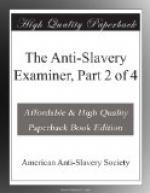When breakfast was ready, Mrs. W. entered the room, and after our introduction to her, took her place at the head of the table. Her conversation was intelligent, her manners highly polished, and she presided at the table with admirable grace and dignity.
On the following day, Dr. Ferguson, of St. John’s, called on us. Dr. Ferguson is a member of the assembly, and one of the first physicians in the island. The Doctor said that freedom had wrought like a magician, and had it not been for the unprecedented drought, the island would now be in a state of prosperity unequalled in any period of its history. Dr. F. remarked that a general spirit of improvement was pervading the island. The moral condition of the whites was rapidly brightening; formerly concubinage was respectable; it had been customary for married men—those of the highest standing—to keep one or two colored mistresses. This practice was now becoming disreputable. There had been a great alteration as to the observance of the Sabbath; formerly more business was done in St. John’s on Sunday, by the merchants, than on all the other days of the week together. The mercantile business of the town had increased astonishingly; he thought that the stores and shops had multiplied in a ratio of ten to one. Mechanical pursuits were likewise in a flourishing condition. Dr. F. said that a greater number of buildings had been erected since emancipation, than had been put up for twenty years before. Great improvements had also been made in the streets and roads in town and country.
MARKET.
SATURDAY.—This is the regular market-day here. The negroes come from all parts of the island; walking sometimes ten or fifteen miles to attend the St. John’s market. We pressed our way through the dense mass of all hues, which crowded the market. The ground was covered with wooden trays filled with all kinds of fruits, grain, vegetables, fowls, fish, and flesh. Each one, as we passed, called attention to his or her little stock. We passed up to the head of the avenue, where men and women were employed in cutting up the light fire-wood which they had brought from the country on their heads, and in binding it into small bundles for sale. Here we paused a moment and looked down upon the busy multitude below. The whole street was a moving mass. There were broad Panama hats, and gaudy turbans, and uncovered heads, and heads laden with water pots, and boxes, and baskets, and trays—all moving and mingling in seemingly inextricable confusion. There could not have been less than fifteen hundred people congregated in that street—all, or nearly all, emancipated slaves. Yet, amidst all the excitements and competitions of trade, their conduct toward each other was polite and kind. Not a word, or look, or gesture of insolence or indecency did we observe. Smiling countenances and friendly voices greeted us on every side, and we felt no fears either of having our pockets picked or our throats cut!




